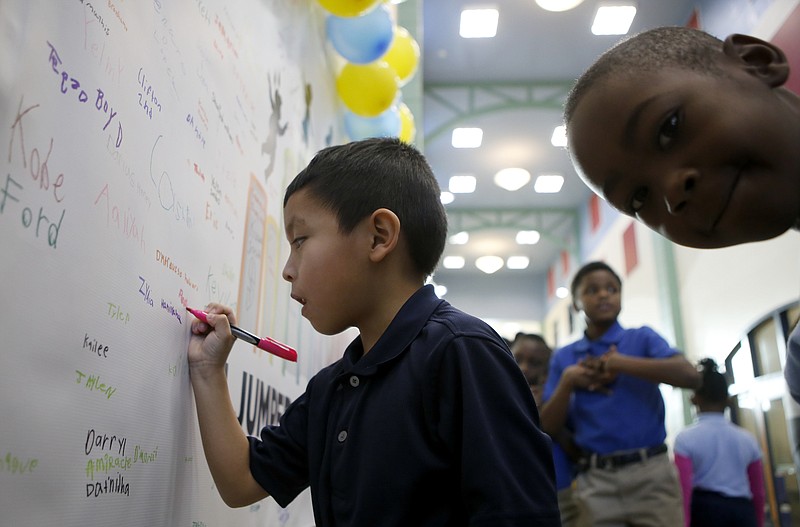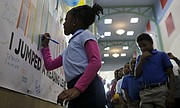Hamilton County Schools officials are tentatively celebrating the progress Opportunity Zone students have made since a new literacy intervention program was launched last fall.
District leaders, including Superintendent Bryan Johnson, school board members Karitsa Mosley Jones and Tiffanie Robinson and other Opportunity Zone administrators gathered Wednesday at Orchard Knob Elementary School to celebrate first-graders at the school.
"We are celebrating these students who have jumped reading levels," Principal LaFrederick Thirkill said. The first-grade cohort highlighted as a success started the school year with only 50 percent of the students reading at grade level - now 58 percent are on or above grade level after the implementation of the R.I.S.E. - Reading Intervention for Student Express - intervention model.
Though just over half of Orchard Knob's first-graders are reading at grade level, the school's data outshines that of its peers.
Opportunity Zone schools
› Brainerd High› Dalewood Middle› Hardy Elementary› Woodmore Elementary› Barger Elementary› Howard High› East Lake Middle› Orchard Knob Elementary› Calvin Donaldson Elementary› Clifton Hills Elementary› East Lake Elementary› Orchard Knob Middle
According to the most recent State Report Card released earlier this month, only 31.5 percent of Hamilton County students in grades 3 to 8 are scoring at or above grade level on English/language arts assessments.
Though first grade is not assessed the same way as third grade, data shows that if students cannot read on level by third grade, they will only continue to slip further behind.
"Research shows that once they are on grade level, they stay on grade level," said Jill Levine, director of the Opportunity Zone.
The Opportunity Zone was launched last fall as the newly installed superintendent's solution for five of Hamilton County's lowest-performing schools as the state threatened to take them over. Previous administrations had unsuccessfully tackled improving the schools through the iZone plan. Twelve total schools are a part of the zone, which Johnson has appointed a team of district officials to lead.
Providing more targeted support is one of the most important components of the zone model. Johnson appointed a leadership team, naming Levine as chief, and asked the Hamilton County Department of Education to approve other support positions such as curriculum and intervention specialists specific to the Opportunity Zone schools and two community school coordinators.
The literacy intervention model was one of the programs that was adopted by all Opportunity Zone schools under Levine's leadership.
The program, first piloted last summer at Hardy Elementary, provides students in kindergarten through fifth grade with 45 minutes of guided reading instruction every day. The students, who are selected based on assessment scores and teacher recommendations meet with one of three guided reading specialists and interventionists for 15 minutes each as they rotate through the classroom. Groups are sometimes as small as the teacher and one or two other students and they work on skills such as vocabulary, comprehension and even phonics.
Last year, the school board approved 15 literacy intervention positions, which have helped staff the R.I.S.E. model in the zone's seven elementary schools. In August, teachers, principals and literacy coaches received initial training to launch the model in their schools, as well as ongoing professional development.
"It's really a model where everyone is accountable to all," Levine said. The early data is promising, she added.
Debbie Rosenow, the Opportunity Zone literacy coordinator, echoed Levine's excitement over the program.
"What we are seeing in the early data is that kids who are in R.I.S.E. for about eight weeks are getting half a year's worth caught up," Rosenow said.
And for many Opportunity Zone students, needed improvement doesn't necessarily look like a level or two. Many kids start school below grade level and are unable to catch up.
By the numbers
Students scoring at or above grade level in grades 3-8 English/language arts:Hamilton County: 31.6 percentStatewide: 33.8 percentStudents scoring at or above grade level in high school English:Hamilton County: 30.6 percentStatewide: 34.7 percent
"Students of poverty come with different needs," Thirkill said. "This is a way to expand the traditional literacy instruction for students and ensure they are getting targeted support."
They often lack resources, support to build literacy skills or sometimes parents who have the ability to support those skills at home, he said.
Being literate, as Thirkill emphasized, rather than just reading also means students can write and can communicate their comprehension. These skills are the foundation of success in other academic subjects such as social studies and science, but even in math.
Students often need basic word recognition and comprehension skills to guide them through math word problems.
Officials can sometimes be hesitant of new programs that promise or initially lead to huge gains, but Levine is confident in the R.I.S.E. model and the benefits it will have for Opportunity Zone students.
"I really believe this is what is going to get us there," Levine said. "This might be what really tackles this issue for once and for all." Levine also believes the layers of support the Opportunity Zone is receiving should lead to tangible progress.
Johnson has emphasized the desire for strategic, streamlined approaches across the Opportunity Zone.
The R.I.S.E. program exists at each elementary school and serves students in all grades. The program has a secondary component as well, which also launched at select Opportunity Zone middle schools in January.
For now, Orchard Knob students are making steady growth, Thirkill said. As students continue to make gains, they are invited to sign an "I Jumped A Level" sign that hangs near the school's front office.
The district partnered with Read 20, a public/private partnership program born out of the Chattanooga area's efforts to boost education and literacy, to recognize the students. Read 20 helped provide the signs for students to sign as well as stickers they could wear to depict their accomplishments. Read 20 aims to promote literacy by encouraging families and community leaders to read with children for at least 20 minutes a day.
Contact staff writer Meghan Mangrum at mmangrum@timesfree press.com or 423-757-6592. Follow her on Twitter @memangrum.

